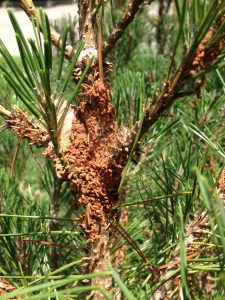
Georgetown, Ontario. Climate zone 5b
Mugo Pine Location:
Sunny conditions 11am to 5pm.
Dry, clay soil conditions.
Problem Noted: The Mugo Pine is being defoliated on the old branch below the new growth or candle.
Evidence: Clusters of pellets. Each pellet measures 2-3mm in length and .5-1mm width. New pellet is green. Aged pellet is brown. Clusters of pellets are held together with a web around the stem and the needles are gone.
Are the pellets eggs, larvae or defecation?
Is it the Web Spinning Saw Fly?
We haven’t seen any insect to identify it.
If so, how do you control the insect?
If the insect is in the soil, should I do something to the soil?
Should I prune out the defoliated branches? If so, how?
Thank you for contacting the Toronto Master Gardeners with your question.
The insect you have identified would appear to be the European pine sawfly. The female of the species has a serrated ovipositor at the tip of her body which allows her to saw slits in the needles of the pine where she lays her eggs. This is the origin of the name “sawfly”. Once the eggs are laid in late summer and early fall, they overwinter until the larvae emerge in the spring and begin defoliating the old growth below the candle. The pellets you mention are actually the larvae which are a dark greenish colour, turning brown as they age. As you mention, they appear as clusters as they tend to eat or defoliate en masse. To get rid of the larvae, the most environmentally-friendly method is to strike the area of the tree sharply which causes the larvae to straighten up so that they can be easily knocked off into a container of soapy water held below the branch. They must not be knocked to the ground in order to avoid more infestation. Defoliated branches can also be pruned to get rid of the larvae in late April or early May. Although the larvae affect the aesthetics of the tree, they do not destroy the affected branches as they feed on needles from previous years and do not harm the new needles forming on the branches. The larvae are also susceptible to harsh weather conditions such as extreme heat and cold so they may not like the heat we are experiencing at the moment. Another aspect of control is directed at the pupa that overwinter in cocoons in the soil. Cultivating the soil exposes them to freezing weather and birds that feed on them. It is therefore recommended to cultivate the soil several times over the winter months, taking care not to damage the roots of the dormant plants.
Here are two websites that might be of interest to you on the subject:
https://ento.psu.edu/extension/factsheets/european-pine-sawfly

